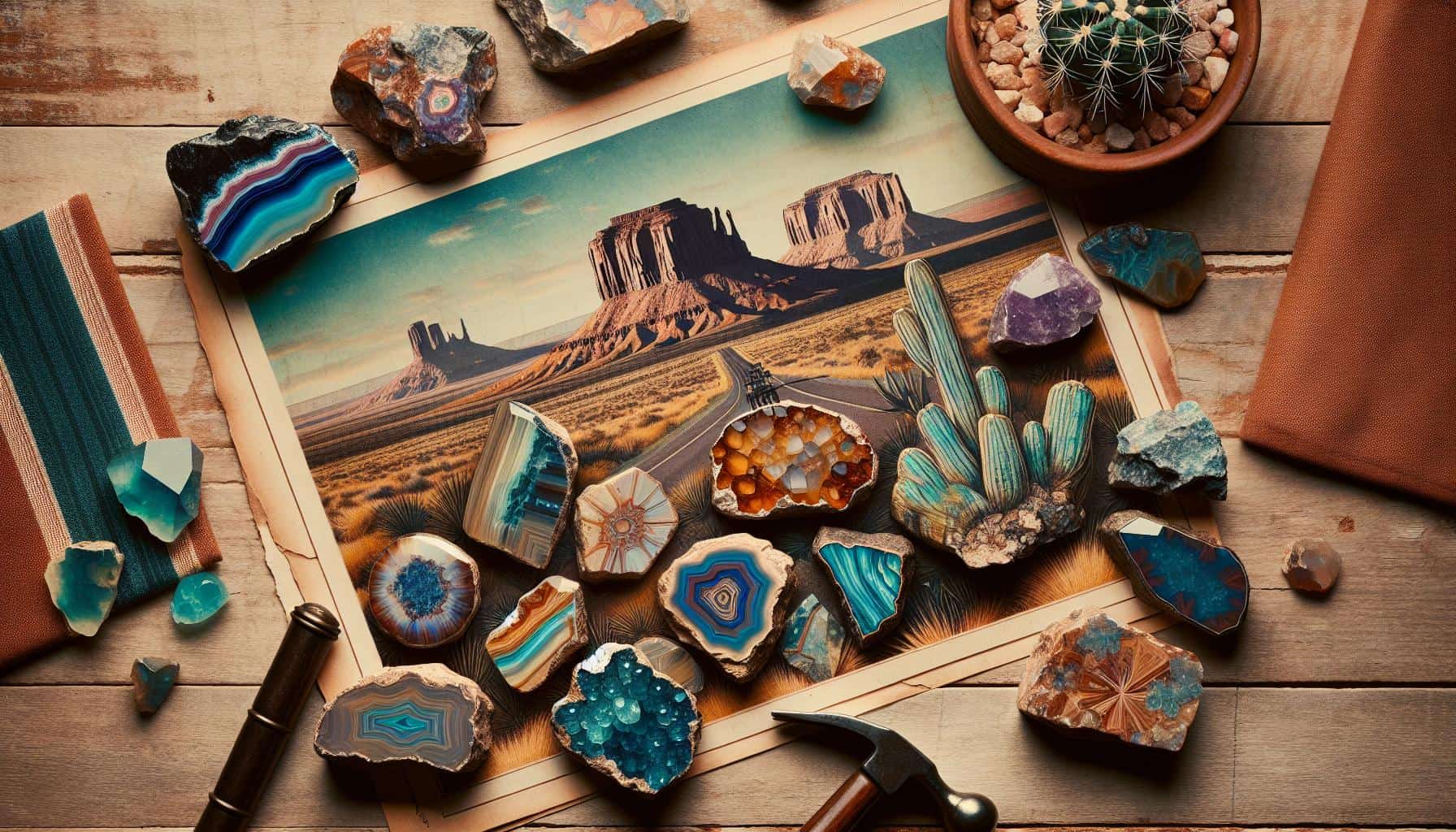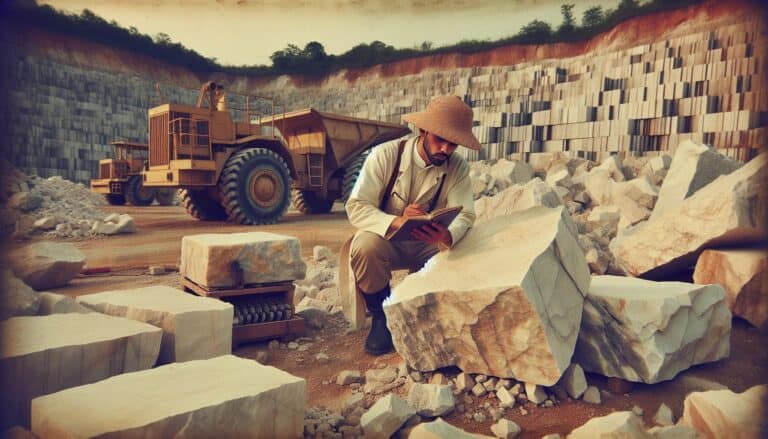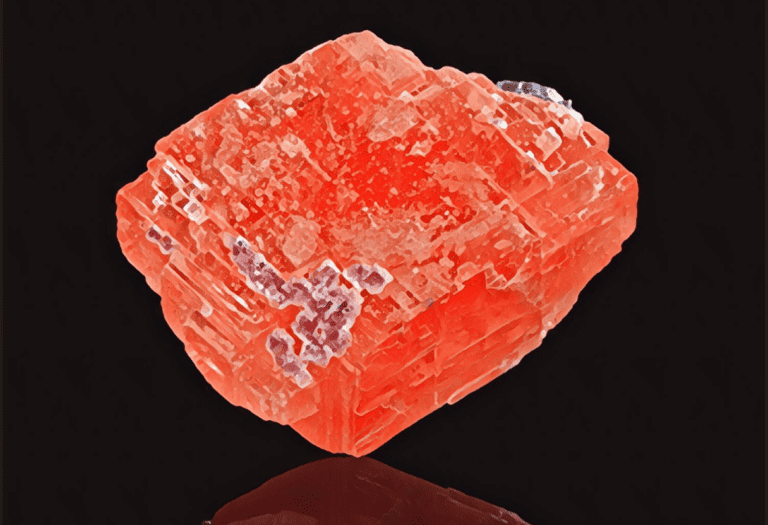Ready to embark on a treasure hunt for natural gems?
Texas, with its vast and varied landscape, is a rockhound’s paradise. Whether you’re a seasoned collector or just starting, the Lone Star State offers an abundance of locations brimming with geological wonders.
From the rugged desert of West Texas to the sandy shores of the Gulf Coast, you’ll find a plethora of sites to explore. You’re not just chasing rocks; you’re on the trail for quartz crystals, agates, petrified wood, and even rare fossils.
Let’s dig into where you can uncover these natural treasures and what incredible finds await you in Texas.
Texas offers rockhounding enthusiasts diverse locations like Big Bend National Park for agate and jasper, Llano Uplift for quartz, Rockdale for petrified wood, and West Texas for agates and geodes. Always check local regulations and obtain permissions for a successful rockhounding experience in Texas.
Texas Rockhounding Locations
When you’re ready to start your rockhounding adventure in Texas, you’re in luck—the state’s geography serves up some incredible spots. With a map in hand and a keen eye, you can unearth Texas’ geological treasures.
Big Bend National Park is a must-visit for any rockhound. The park’s vast area has a wealth of minerals like agate, jasper, and even rare gem-quality red plume agate. Remember, while collecting rocks and minerals in national parks is prohibited, you can still enjoy the thrill of discovery and photograph your finds.
For quartz lovers, the Llano Uplift is your go-to spot. It’s a geologic anomaly where you’ll find an abundance of quartz varieties. Areas around Mason County, known as the “Gem of the Hill Country,” might just yield that perfect specimen to add to your collection.
If petrified wood fascinates you, don’t miss the Petrified Forest of Rockdale. It’s sprawled out over private lands, so you’ll need permission to collect, but it’s worth the effort for the unique samples you can find.
- West Texas is renowned for its agates and geodes. The Woodward Ranch and Walker Ranch, both offering pay-to-dig options, are treasure troves for rockhounders.
Here’s a snapshot of what you can find and where:
| Location | Collectible Materials |
|---|---|
| Big Bend National Park | Agate, Jasper |
| Llano Uplift | Quartz, Topaz |
| Rockdale | Petrified Wood |
| West Texas | Agates, Geodes |
Always check for the latest local regulations and obtain any necessary permissions before rockhounding. Some areas may fall on private property or have restrictions for collecting. Equip yourself with the right tools—safety goggles, a sturdy hammer, and gloves to protect your hands.
Texas’ natural bounty is vast and the opportunities for discoveries are almost endless. Whether you’re sifting through the streams in Central Texas or exploring the dusty trails of West Texas, your rockhounding journey is bound to be as rewarding as it is exciting. Get out there and see what natural gems you can uncover in the Lone Star State.
What Gemstones are Found in Texas?

Texas is a treasure trove for gemstone enthusiasts. You will find a variety of gems, each with its unique charm and characteristics. Topaz, the state gem of Texas, especially draws gem hunters to the area. Mason County, colloquially known as Topaz Country, is the prime spot if you’re searching for these blue beauties.
Besides topaz, Texas is a well-known source of blue agates and amethyst. The West Texas deserts sparkle with these precious stones waiting to be unearthed by keen eyes. You may want to visit the Last Frontier for your chance to add these to your collection.
- Topaz: Can be found in Mason County.
- Blue Agates: Primarily found in West Texas.
- Amethyst: Available at select locations in West Texas.
Additionally, you’ll stumble upon jasper and opal. Jasper, with its earthy tones and intricate patterns, is scattered throughout the state, while the elusive opal can be found in the siliceous layers of West Texas.
For those interested in softer minerals, Texas has a reserve of talc. Renowned for its softness, talc deposits near the Rio Grande offer a softer yet interesting rockhounding opportunity.
| Gemstone | Primary Locations |
|---|---|
| Topaz | Mason County |
| Blue Agates | West Texas |
| Amethyst | West Texas |
| Jasper | Statewide |
| Opal | West Texas |
| Talc | Near Rio Grande |
Remember, while rockhounding for gemstones, it’s not just about the find; it’s also about the adventure, the landscapes, and the thrilling experience of discovery. Each trip out into the vast Texas terrain promises an opportunity to add a rare and beautiful piece to your collection. Make sure your rockhounding toolkit is equipped and get ready to explore the geologic wonders of the Lone Star State.
What Sedimentary Rocks You Can Find in Texas?

As you delve into the world of rockhounding in Texas, you’ll find that the state is a treasure trove for sedimentary rocks. Sedimentary rocks are formed by the accumulation and consolidation of sediments, and Texas’ vast history has paved the way for a rich variety of these geological marvels.
Limestone, a cornerstone of sedimentary rocks in Texas, can be commonly found. This rock is not only abundant in the state’s architecture but also among the hills and valleys that make up the Texan landscape. Limestone caves and fossils within them are particularly fascinating for rockhounds and geologists alike.
Shifting your attention to the coastal plains of Texas, you’ll encounter sandstone formations. The warm hues of the sandstone cliffs offer a picturesque view and a potential cache of sedimentary specimens. When you’re exploring these areas, be mindful of the natural beauty and ensure that your rockhounding practices are sustainable.
Texas is also home to shale, often seen in the northern parts of the state. This fine-grained sedimentary rock can contain traces of gas and oil, reflecting the state’s rich resources. Whether it’s the black shales of North Texas or the colorful variations found in other regions, each piece tells a story of Earth’s past.
Don’t overlook the possibilities of finding siltstone and claystone deposits in Texas as well. These sedimentary rocks, while not as prominently featured in discussions, can offer their own unique appeal to collectors. With a bit of patience and a keen eye, you might discover these lesser-known specimens to round out your collection.
As you continue to explore the sedimentary offerings of Texas, remember that each rock, from the common limestone to the inconspicuous claystone, is a piece of the puzzle that is the geologic makeup of the Lone Star State. Keep your field guide handy, and embrace the diversity of sedimentary rocks that Texas has to offer.
What Metamorphic Rocks are found in Texas?
When exploring the vast geological tapestry of Texas, you’ll uncover that the state is not only rich in sedimentary and igneous rocks but also metamorphic rocks. These rocks have undergone profound changes due to intense heat, pressure, and chemical processes, presenting rockhounds with a unique set of minerals to discover.
In the Llano Uplift, a geological wonder in Central Texas, you’re most likely to encounter massive amounts of schist and gneiss. Particularly, the Llano Uplift is noted for its age and complex history, dating back over a billion years. These rocks are not only intriguing for their color variations but for the story of Earth’s history they tell.
- Schist: often shimmering with mica and can be found in ranges of silver, gold, and rusty hues.
- Gneiss: typically exhibits a banded texture with alternating layers of light and dark minerals.
Another key region is the Van Horn area, where you might stumble upon notable amounts of marble and quartzite. Marble here is generally metamorphosed from limestone, offering a diverse palette of colors due to various mineral impurities. Quartzite, on the other hand, starts off as sandstone and transitions into an incredibly hard rock, ideal for collecting.
Maintaining eco-friendly practices during your rockhounding adventures is crucial. Remember to collect responsibly to help preserve these natural wonders for future generations.
| Rock Type | Location | Characteristics |
|---|---|---|
| Schist | Llano Uplift | Shimmering with mica, varied hues |
| Gneiss | Llano Uplift | Banded texture, light and dark layers |
| Marble | Van Horn area | Metamorphosed limestone, colorful |
| Quartzite | Van Horn area | Started as sandstone, now very hard |
While staurolite and kyanite are less common, they are still notable metamorphic finds in Texas, occasionally unearthed by persistent rockhounds. Equipped with your rock hammer and curiosity, Texas offers a metamorphic bounty that’s as vast as the state itself. Dig in and discover the hidden metamorphic gems that enrich the Lone Star State’s geologic landscape.
What Igneous Rocks can You Find in Texas?
Texas’s geological diversity isn’t limited to sedimentary and metamorphic rocks. Igneous rock enthusiasts will find a variety of locations rich with unique finds. As you traverse the state’s vast landscapes, keep an eye out for Texas’s igneous rock formations, formed from cooled magma and offering a thrilling hunt for rockhounding aficionados.
Granite prominently marks its presence in Texas. One notable location is Enchanted Rock State Natural Area, where a massive pink granite dome not only offers a spectacular view but also a chance to find this coarse-grained igneous rock. Similarly, Big Bend National Park provides rockhounds with rhyolite, a volcanic rock with a high silica content often showcasing intricate banding patterns.
In the West Texas region, near the towns of Alpine and Marfa, you’ll stumble upon basalt—a fine-grained igneous rock. Basalt is a foundation of many ancient lava flows and might contain vesicles that once held gas bubbles, which now serve as small, interesting cavities within the rock.
For those particularly interested in rare igneous discoveries, peek around the Davis Mountains, where you might be lucky enough to find peridotite. It’s a dense, dark-colored rock containing minerals like olivine and pyroxene; finding it can be a highlight of your rockhounding expedition.
To offer a quick snapshot of igneous rocks available in these prime Texas locations, here’s a convenient table:
| Location | Igneous Rock | Notable Features |
|---|---|---|
| Enchanted Rock State Area | Granite | Massive dome, coarse-grained texture |
| Big Bend National Park | Rhyolite | High silica, banded patterns |
| Alpine and Marfa | Basalt | Fine-grained, vesicular texture |
| Davis Mountains | Peridotite | Dense, contains olivine and pyroxene |
Keep in mind that rockhounding requires permission where necessary, and always respect the natural environment. Be sure to research and understand the local rules and regulations before embarking on your igneous rock adventure. Texas’s igneous rocks are not only geological wonders but also pieces of Earth’s deep history waiting for you to uncover.
Panning for Gold in Texas
When you venture into the heart of Texas, the allure of finding gold is ever-present. The state’s history is replete with tales of gold rushes and hidden treasures. Although it’s not commonly known as a major gold producer, Texas offers several spots where you can pan for gold and possibly make your own exciting discovery. Below are recommended locales where panning is allowed and where you might just strike it rich.
Llano River is a top pick for panners. Gold found here is typically fine and flakey, yet prospecting can yield rewarding results. The river runs over granite, which is where the gold originates, broken free from its matrix by the forces of erosion and weathering.
- Mason County’s Streeter area
- Bed of the Sandy Creek
- Areas near Kingsland and Llano
Embrace the adventure in creeks and streams within Gold Pan State Park where panning is explicitly permitted. While the chances of a major find are slim, you’re likely to uncover small flakes that can fuel your passion for gold panning.
Safety first, though. Always ensure you have the right permits and permissions before heading out with your pan in hand. Many sites require a minimal fee which contributes to the maintenance of Texas’ beautiful natural resources.
Here’s a brief rundown of the equipment you’ll need:
- Gold pan
- Shovel or scoop
- Snuffer bottle
- Vials to store your finds
Seasoned panners suggest heading to these spots after a rain when the water has had a chance to stir up and potentially reveal more of the precious metal. Patience and persistence are essential, as gold panning is as much about the hunt as it is about the find. Keep an eye on the water’s flow areas with natural traps, like crevices or behind large rocks, where gold is likely to accumulate.
Be mindful that water levels can change, and with it, the accessibility to potential gold-bearing areas. With the right approach, your search for gold in Texas could be a gratifying addition to your rockhounding journey.
Rocks and Minerals Found in Texas
When you’re trekking across Texas in search of geological treasures, you’ll be pleased to find a diverse array of rocks and minerals. Each region offers a unique bounty that reflects the state’s complex geology.
In the central parts of Texas, Llanite, a type of granite with prominent blue crystals, awaits at Lone Star’s locales like Llano County. This rare rock is a sight to behold and sought after by collectors for its distinctive look.
Venturing into West Texas, you might stumble upon agates and jaspers, especially in the rough terrain surrounding Big Bend. These colorful, banded stones are perfect for lapidary work and make striking jewelry and decorative pieces.
Petrified wood can be unearthed in the Post Oak Savannah and Blackland Prairies Region, bearing witness to ancient forests that once thrived there. These fossilized remains have been turned to stone through the process of permineralization, and each piece is a unique snapshot of history.
If it’s something more crystalline you’re after, head to the Central Mineral Region where quartz varieties such as amethyst and smoky quartz dot the landscape. The clarity and quality of these crystals can be quite remarkable.
Don’t overlook the state’s fossil wealth. Shark teeth and echinoids are reminders of Texas’s underwater past. They can be found in areas like North Central Texas and along many of the state’s waterways.
To enhance your chances of discovery, here is a quick list of minerals grouped by commonly found types and locations:
- Quartz family variants: Central Mineral Region
- Petrified wood: Post Oak Savannah, Blackland Prairies
- Agates and Jaspers: West Texas, especially near Big Bend
- Llanite: Llano County
Equipped with this knowledge, you can pinpoint potential rockhounding hotspots across Texas’s vast landscapes. Remember to always tread lightly, respect the land, and adhere to the local collecting laws for a fruitful and ethical rockhounding adventure.
Where Can I Find Fossils in Texas?
Your quest for fossils in Texas is bound to be an exhilarating adventure as the Lone Star State’s sedimentary strata hide marvels from ancient seas, rivers, and lands. These relics of prehistoric life abound in several hotspots across the state.
North Texas is renowned for its Cretaceous limestone which often yields ammonites and various marine fossils. Sites like Ladonia Fossil Park invite you to scour the riverbanks where creatures from 80 million years ago have left their mark encased in stones. Don’t forget to visit Lake Texoma, one of the best places for finding well-preserved fossils of sea dwellers.
Transitioning to Central Texas, the story of life is etched in the limestone and shale layers. At sites like Mineral Wells Fossil Park, you can find delicate crinoids, trilobites, and brachiopods. It’s a straightforward dig site where the earth reveals its secrets quite willingly to those who look with a keen eye.
In the Austin area, keep your eyes peeled for the iconic and state fossil of Texas, the Petrified Palmwood. It dazzles collectors with its intricate patterns and is a relic from when the state’s climate was decidedly more tropical.
If it’s prehistoric vertebrates you’re after, venture to the Big Bend region in West Texas. This rugged landscape was once home to dinosaurs and the fossils found here are a testament to these giants that roamed earth millions of years ago. Big Bend National Park does permit casual fossil viewing but stresses that you may look but not take.
For a more organized fossil-hunting experience, you might consider joining a local paleontology society or club which often have field trips to various sites around the state.
Remember, collecting fossils entails the same guiding principles applicable to rockhounding; respect the rules, preserve the natural setting for future enthusiasts, and maintain the integrity of these scientific treasures for study and awe. Go out prepared with the right tools, a sense of adventure, and a commitment to conservation. You’re not just collecting fossils; you’re uncovering the Earth’s vast history.
Texas Rockhounding Laws & Regulations
When you’re out rockhounding in Texas, it’s crucial to be aware of the local laws and regulations that govern the collection of rocks, minerals, and fossils. Understanding these rules ensures that you’re rockhounding responsibly and legally.
Private Land and Permission: In Texas, much of the land is privately owned. You’ll need explicit permission from landowners before you can collect on their property. Trespassing on private property without consent can lead to legal consequences.
Public Lands and Limits: On public lands, such as certain parks and beaches, rockhounding is often permitted but with limitations. Collecting may be restricted to small quantities for personal use only, and tools like shovels or picks may be prohibited to prevent damage to the natural environment and habitats.
- Check with the park’s visitor center or website for specific rules
- Always adhere to “leave no trace” principles
- Respect wildlife and natural formations
Fossils and Artifacts: Fossil collecting has additional rules, especially when it comes to vertebrate fossils which are significant for scientific value. It’s illegal to collect vertebrate fossils on state land without a permit. When it comes to Native American artifacts, removing them from public lands is strictly against the law.
| Texas Regulations | Details |
|---|---|
| Private Land Collection | Permission required from the landowner |
| Public Land Collection | Allowed with limitations; may be quantity and tool use restrictions |
| Vertebrate Fossil Collection | Permit needed for collection on state lands |
| Artifact Collection | Illegal to remove Native American artifacts from public lands |
Lastly, some locations are completely off-limits for collection due to their protected status as historical sites or conservation areas. Your best course of action is to research specific locations before your rockhounding adventure. Local clubs often have up-to-date information and can guide you through the do’s and don’ts of collecting in the area.
Rockhounding Tips for Beginners in Texas
Gearing Up: Essential Tools for Rockhounding
To maximize your rockhounding experience in Texas, you need the right tools for the job. Starting with the basics:
- Rock hammer or geologist’s hammer: This is a must-have for breaking rocks and extracting specimens.
- Safety goggles: Protect your eyes from flying debris.
- Gloves: Choose gloves that offer a good grip and protection against sharp edges.
- Durable backpack: Opt for one that can withstand the rigors of outdoor activities.
- Sturdy footwear: Hiking boots are ideal for navigating rough terrains.
- Chisels and brushes: These will help you delicately extract and clean your finds.
- Field guidebook: To identify rocks and minerals you discover.
- Water bottle: Stay hydrated while on your quest for geological treasures.
Remember, as your skills progress, so can your toolkit; invest in more specialized equipment like a GPS or a UV light for fluorescent minerals as needed.
Safety Tips While Rockhounding
Your safety should always come first. Here are critical tips to keep in mind:
- Always notify someone about your rockhounding location and expected return time.
- Be mindful of the weather forecast and prepare accordingly—extreme heat or sudden storms can be dangerous.
- Watch out for wildlife and be aware of the potential for snakes, especially in remote areas.
- Stay on designated trails and beware of loose rocks and unstable overhangs.
- Keep a first-aid kit and a whistle within reach.
- Use sun protection including sunscreen, a hat and UV-blocking sunglasses.
- Respect private property and do not trespass.
By taking these precautions, you can help ensure that your rockhounding adventure is not only productive but also safe.
Legal Guidelines for Rockhounding Enthusiasts
Understanding the legal landscape is key when rockhounding in Texas:
- Always obtain permission before collecting on private land.
- On public lands, be aware of the specific collecting rules, which can differ from one area to another.
- Do not collect vertebrate fossils or Native American artifacts as it is illegal without proper permits.
- Familiarize yourself with the American Federation of Mineralogical Societies’ Code of Ethics; it offers guidelines to promote responsible collecting.
- Research local laws in the area you plan to visit. Some parks may have strict regulations against removing natural materials.
Be a responsible collector; preserving the environment and respecting the law will ensure that rockhounding remains an enjoyable hobby for everyone.
Conclusion: Texas Rockhounding Locations
You’re now equipped with the knowledge to go rockhounding across the Lone Star State.
Whether you’re drawn to the unique Llanite of Llano County, the vibrant agates of West Texas, or the historical fossils along the waterways, Texas offers a treasure trove of geological wonders. Remember to pack your essential tools, follow safety guidelines, and respect legal regulations when collecting. Don’t forget to tap into local clubs for the latest insights and locations. With this information, you’re ready to explore the diverse and rich terrain of Texas.
Happy rockhounding!







